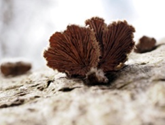Further notes from the Vereley and Ridley Woods walk by Andy Skarstein
Ridley Wood is ancient, coppiced from the
1500’s until 1698 when the practice of pollarding Oak and Beech trees was
forbidden in the New Forest by an Act of Parliament ,so as to safeguard long timber
for the navy.[1] The woods have many fallen and dead trees,
mainly beech, but some oak too, both providing valuable habitat.
“From medieval times the wood was used for
coppicing. Ridley Wood is mentioned in Norden’s 17th
century survey of coppices as a place where land was leased to tenants for
exploitation of the underwood only. In
1571, the tenant of Ridley Coppice was accused of pollarding 200 trees and
selling the cut wood, thus exceeding his rights. To compound his crime, he also
cut young oak to make fences.”[2]
Beech
trees are not usually long lived, 300 years on average. They are very thirsty, so suffer from lack of
rain, though don’t like water logged soil either. In the New Forest they are vulnerable to being
blown over as their wide spreading roots don’t enter the clay below.
Information of where to find
Ancient and Veteran trees in the UK can be found at https://ati.woodlandtrust.org.uk/?_gl=1*1rra7da*_ga*NjQ4ODAwMjg0LjE2NDQ4NzA4MDU.*_ga_YYKVQEPV0X*MTY1MDczOTk3MC4xNi4xLjE2NTA3NDAxNDEuNTU Just put a place
into the search facility, then click on a highlighted tree, a small box will
pop up telling you what the tree is, click on the box and more info and photos
will come up regarding that particular tree.
A PDF can also be downloaded
from the Woodland Trust explaining what ancient, veteran and other trees of
interest are: https://www.woodlandtrust.org.uk/publications/2008/11/what-are-ancient-trees/?_gl=1*d8bs8*_ga*NjQ4ODAwMjg0LjE2NDQ4NzA4MDU.*_ga_YYKVQEPV0X*MTY1MDczOTk3MC4xNi4xLjE2NTA3NDA4MDYuMTI.
Mill
Lawn Brook was
crossed twice. It rises just south of
the A31 and is fed by additional tributaries rising from Harvest Slade Bottom
before flowing through Burley and then eastward via Markway Bridge and
Puttles Bridge where it becomes known as Ober Water. The Ober Water continues to flow eastwards to
the north of Brockenhurst where it joins the Lymington River at Bolderford Bridge. [3]
Ridley Bottom: In the brook itself we spotted
Water-crowfoot. We had some discussion
about whether or not we were looking at Ranunculus
novae-forestae– named for the New Forest, where it was first found. A crib sheet separating out the different
Water-crowfoot species can be found at https://freshwaterhabitats.org.uk/wp-content/uploads/2015/03/THREE_LOBED-WATER-CROWFOOT-CRIB-SHEET.pdf
The
other notable plant seen was Petty Whin, which was just coming into
flower. It has decreased drastically
across the UK and apart from the New Forest is found only in eastern Scotland,
south Wales and Devon. It grows in moist
open grasslands and heathland on acid soils. It likes areas where the ground
does not get too dry and where the soil is a little richer. The drier fringes
of bogs and acid pasturelands are ideal for it. This is a species that
definitely requires grazing. One of the
main reasons for its decline has been a lack of grazing in many places where it
used to grow. [4]
One
of the fungus we saw was the miniscule Grey Disco which is a ‘spore
shooter’. It is common in Britain and is found on dead wood, usually on the
underside of logs when rolled over.
Another fungus was Split Gill, a small fan like wood rotting fungus (below). Interesting information about this common fungus can be found at https://botit.botany.wisc.edu/toms_fungi/feb2000.html
The slime mould ‘False Puffball’ (below) was seen
in its reproductive phase as a white 'swelling' on a branch of a fallen
tree.

